Theropoda
Theropoda was a group containing all the two-legged meat-eating dinosaurs. They emerged during the late Triassic period and continued until the end of the age of dinosaurs. Ceratosauria were a group of primative theropods and included Coelophysis and probably Procompsognathus. Herrerasauridae were another primative group. The Tetanurae were a more advanced group, and included Carnosauria (such as Allosaurus) and the Coelurosauria. This group contained the Tyrannosauridae, the Ornithomimidae and the Mairaptora.
Procompsognathuspro-KOMP-sog-NATH-us(before delicate jaw) Dr E. Fraas (1913) Europe Late Triassic 1.2m |
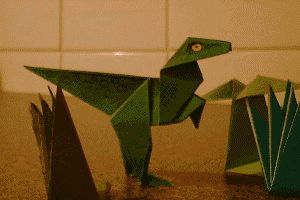
|
| Procompsognathus may have been one of the earliest ceratosaurs. It was one of the smallest ever dinosaurs and was probably a fast moving scavenger. In the novel Jurassic Park, they were bred to digest the faeces of the other dinosaurs (yuck). Some controversy has arisen as to whether the skull of the specimein dicovered was that of procompsognathus or of an early crocodilian, so its classification is uncertain. |
Difficulty **
|
Compsognathuskomp-SOG-nath-US(delicate jaw) Dr J.A. Wagnar (1859) Europe Jurassic 1.4m |
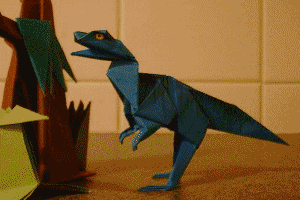
|
| Composgnathus was a hen-sized dinosaur from the Jurassic period. This little scavenger lived in herds during the Jurassic period in the areas now know as France and Germany. When the original skeleton was found, the head was arched up over the head, suggesting that the animal died in agony. This gave support to one theory that some jurassic dinosaurs died out due to poisoning. It has later been noticed that when some birds die, this arching is actually due to neck muscles drying out. |
Difficulty ***
|
CoelophysisSEEL-oh-FY-sis(Hollow-form) Dr E.D. Cope (1889) North America Late Triassic 3m long |
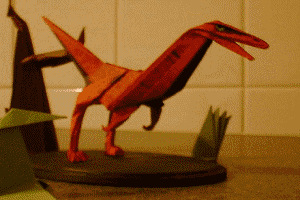
|
| Coeophysis is one of the oldest well-known dinosaurs. In 1947, hundreds of these creatures were found in New Mexico. They were slim agile scavengers that emerged towards the end of the Triassic period. Their fast speed and water conserving physiology meant that they could out-compete many of the most ancient reptiles of the Triassic era. As well as having strong claws, Coelophysis had a mouth full of sharp teeth, indicating its carnivorous status. |
Difficulty ****
|
AllosaurusAL-oh-SAW-rus(Different Reptile) Dr O.C.Marsh (1877) North America Jurassic 12m long |
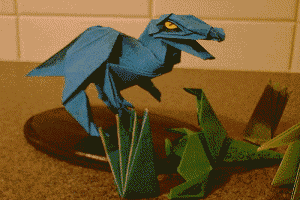
|
| Allosaurus was the main meat-eating dinosaur of the Late Jurassic in North America. It had powerful jaws and sharp slashing claws on its forelimbs. At the time, it was the largest land carnivore on the planet, reaching sizes of up to 12 meters long. |
Difficulty *** |
TyrannosaurusTie-RAN-oh-SAW-rus(Tyrant reptile) Prof H.F. Osborn (1905) North America Late Cretaceous 14m long |
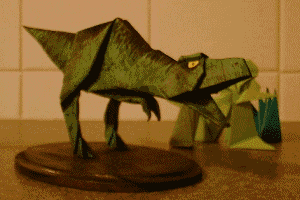
|
| Tyrannosaurus is probably the best known dinosaur. It is the largest land carnivore that ever stalked the earth, being almost 6 meters tall. Although it had very small forelimbs, its jaws were massive, probably large enough to swallow a human whole. Its teeth, up to 30 cm long were serrated and were likely to have acted as reservoirs for toxic bacteria, making its bite semi-poisonous. Its long, heavily muscled legs and balanced body suggests that it could run fairly swiftly. It is still not sure whether T-rex was a hunter or a scavenger. I much prefer its portrayal as the berzerk killer as seen in Jurassic Park; a scavenger T-rex just wouldn't be any fun, would it? |
Difficulty *** |
Velociraptorvel-O-si-RAP-tor(fast thief) Prof. H.F. Osborn (1924) Mongolia Cretaceous 1.8m |
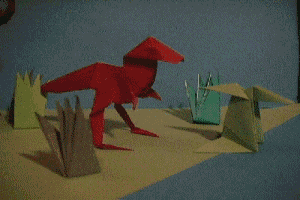 |
| Velociraptor was a medium sized meat-eater. It was quite intellegent and may have hunted in packs. It had sharp claws on its forearms and a large scythe-like claw on the inside toe of each foot. They were probably not as dreadful as the monsters portrayed in the film Jurassic Park; they were a fair bit smaller than those portrayed. They were still vicious enough to prey on smaller dinosaurs such as Protoceratops. It was part of a group called Dromaeosauridae, a division of the Maniraptora. |
Difficulty ** |
DeinonychusDIE-no-NIKE-us(Terrible-claw) Dr J.H. Ostrom (1969) Montana Cretaceous 3m |
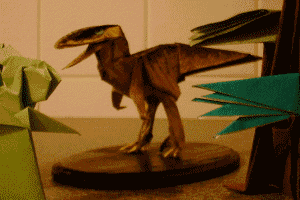 |
| Deinonychus was similar to Velociraptor in shape but was much larger. As tall as a man, its foot claw was nearly a foot long. It would have used this to slash open its prey as it leapt on them. Its tail was stiffened and balanced the body, allowing deinonychus to attack with one foot at a time. This dinosaur too was a dromeosaurid. |
Diagrams |